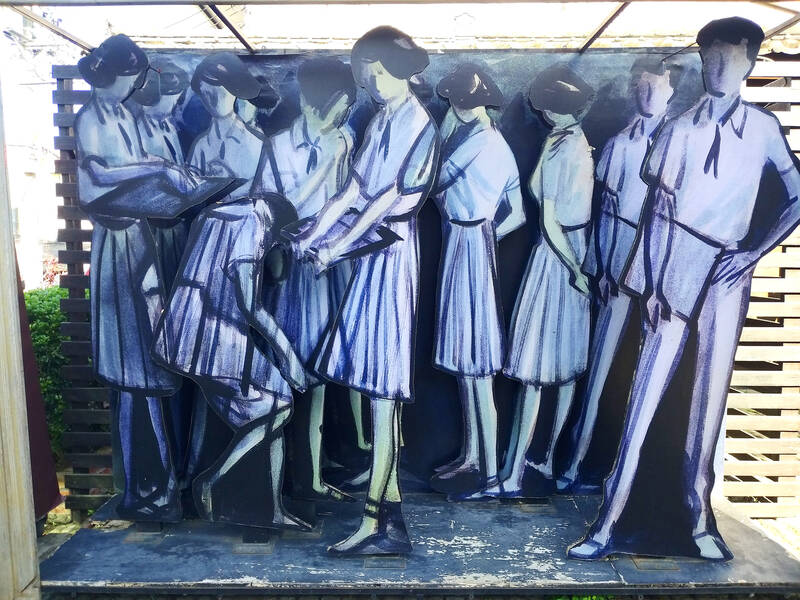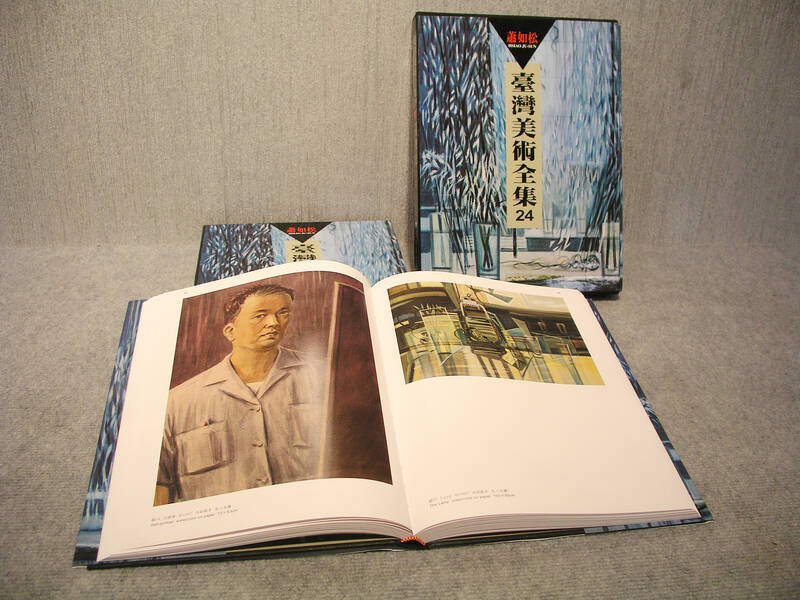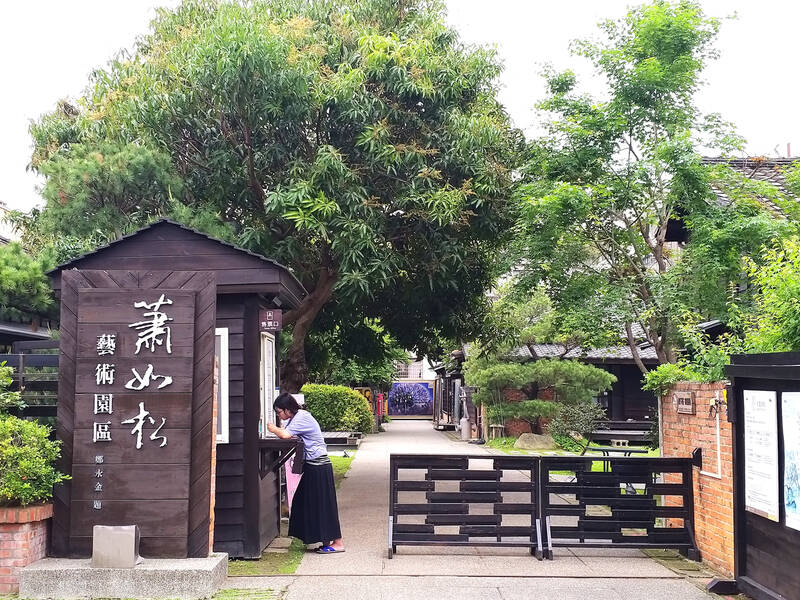SEPT. 19 to SEPT. 25
Hsiao Ju-song (蕭如松) had big shoes to fill. His father became the first Taiwanese lawyer during Japanese rule — passing the exam without any formal study — while his older brother was an esteemed physician with a Doctor of Medicine degree from Germany. He even served as a lieutenant during World War II, a rank that few Taiwanese attained.
Despite their achievements, the family wasn’t wealthy, and high hopes were placed on Hsiao when he became one of four Taiwanese students accepted into the prestigious Taihoku First High School (today’s Taipei Municipal Jianguo High School, 建國中學).

Photo: Liao Hsueh-ju, Taipei Times
Facing discrimination at school and suffocating pressure at home, Hsiao found solace in painting. His parents forbade him from making art at home, but he always found a way — whether it was sketching on scraps of paper stolen from his father’s study, or doodling in his workbooks while pretending to study.
At the age of 17, Hsiao was selected to exhibit at the 1939 Taiyang Fine Arts Exhibition. Aside from a brief hiatus, he participated in the show every year until 1991, submitting more that 70 pieces.
When Hsiao insisted on pursuing art as a career, his family called him a traitor and a good-for-nothing, refusing to provide him with any financial support. Supplies were scarce due to World War II, and for two years he subsisted mostly on taro leaves while studying to be an art teacher at Hsinchu Normal University, greatly damaging his health.

Photo: Liang Hsiu-hsien, Taipei Times
Today, Hsiao is remembered as a low-key, yet important watercolor painter and a strict but passionate art teacher, with an art park dedicated to him around his former residence in Hsinchu’s Jhudong Township (竹東). Hsinchu County has been putting on a series of events starting last month to commemorate his 100th birthday, which falls on Tuesday.
FIRST LAWYER
Hsiao’s tenth generation ancestor was one of the first Han Taiwanese to settle in the future Hakka settlement of Beipu Township (北埔), Hsinchu County.

Photo: Liao Hsueh-ju, Taipei Times
His father, Hsiao Hsiang-an (蕭祥安), trained to become a teacher, although his true interest was law. Ling Chun-yu (凌春玉), who has done much research on the family, writes that the elder Hsiao continued to study in his free time, and in 1919 passed the high-level civil servant examinations to become a translator for the Taipei High Court and the Governor-General’s Advisory Council.
This was already a rare accomplishment, Ling writes; only about 50 Taiwanese passed the high-level examinations during the half century of Japanese rule, and even fewer were hired on. In 1923, the elder Hsiao reportedly served as crown prince Hirohito’s personal translator for his 12-day tour of Taiwan, and played shogi, also known as Japanese chess, with the royal during their down time.
The Great Depression in 1929 also affected Taiwan, and to provide a better living for his eight children, the elder Hsiao decided it was time to try for the legal exams. In late 1936, he became the first Taiwanese to pass the exams and started his legal practice in Taipei the following year. He served as the deputy chairman of the Taipei Attorney’s Association in 1940, the only member who did not attend law school or study abroad.
FAMILY CONFLICT
Hsiao Ju-song was born in 1922 as the youngest of the eight children. His name was given to him by Wu Hung-chi (吳鴻棋), a judge and close friend of his father’s.
There was an art museum near his elementary school (it’s unclear which one), and he would secretly visit after class to admire the paintings. At home, he copied them on whatever paper he could get his hands on, often drawing in the attic until late at night.
One of the art teachers in Hsiao’s high school was the well-known painter Shiotsuki Toho. Although Hsiao didn’t learn directly from him, Shiotsuki heard of his talent and met with him a few times to look over his work. Hsiao credits this chance as a major inspiration.
At the height of the Allied attacks during World War II, Hsiao’s family disguised themselves and hid in a small farmhouse in Jhudong. Hsiao joined them for a short period.
Ling writes that Hsiao was already somewhat eccentric. Sporting a beard and unorthodox clothing, he wandered the area painting the scenery and was at one point arrested by police. He was released only after they learned who his father was.
DISCIPLINED ARTIST
After the war, the Hsiaos fled Taipei again when 228 Incident broke out. Wu refused to leave, and was arrested and executed during the brutal crackdown on the anti-government uprising.
The family settled in Hsinchu, and Hsiao Ju-song taught art at various schools in Jhudong until his retirement in 1988. Jhudong High School students referred to him as one of the three “campus oddities,” as he was always dressed completely in gray, carrying a huge stack of teaching materials up and down the hill from his house to class.
But Hsiao was greatly respected. He was very strict about student behavior and manners, making everyone clean their shoes before entering the classroom. But he was passionate and cared deeply about their learning. He won 11 national educator awards, and also held summer and winter vacation art programs free of charge.
Ling writes that Hsiao didn’t mind whether his students went on to become artists or not; he believed that art education was crucial for one’s humanistic development.
Hsiao was just as disciplined at home, waking up early to tend to the plants and clean his house. He spent almost all of his free time painting or reading about art. He was incredibly consistent as well, participating in a number of art shows every year until his death.
Hsiao kept a very low profile. He detested any attention, believing that an artist should just work hard in silence, only reluctantly holding his first solo show at the Apollo Gallery in 1988 after much persuasion.
In 1992, the gallery submitted several of Hsiao’s works behind his back to the Wu San-lien Creative Arts Award, which he won.
“I don’t know if I should thank you or be mad at you,” an embarrassed Hsiao told the gallery owner at the awards ceremony.
He died later that year from a heart attack.
“For my whole life, I’ve just been an amateur artist’, he once said. “But I’ll always give my all.”
Taiwan in Time, a column about Taiwan’s history that is published every Sunday, spotlights important or interesting events around the nation that either have anniversaries this week or are tied to current events.

May 11 to May 18 The original Taichung Railway Station was long thought to have been completely razed. Opening on May 15, 1905, the one-story wooden structure soon outgrew its purpose and was replaced in 1917 by a grandiose, Western-style station. During construction on the third-generation station in 2017, workers discovered the service pit for the original station’s locomotive depot. A year later, a small wooden building on site was determined by historians to be the first stationmaster’s office, built around 1908. With these findings, the Taichung Railway Station Cultural Park now boasts that it has

Wooden houses wedged between concrete, crumbling brick facades with roofs gaping to the sky, and tiled art deco buildings down narrow alleyways: Taichung Central District’s (中區) aging architecture reveals both the allure and reality of the old downtown. From Indigenous settlement to capital under Qing Dynasty rule through to Japanese colonization, Taichung’s Central District holds a long and layered history. The bygone beauty of its streets once earned it the nickname “Little Kyoto.” Since the late eighties, however, the shifting of economic and government centers westward signaled a gradual decline in the area’s evolving fortunes. With the regeneration of the once

The latest Formosa poll released at the end of last month shows confidence in President William Lai (賴清德) plunged 8.1 percent, while satisfaction with the Lai administration fared worse with a drop of 8.5 percent. Those lacking confidence in Lai jumped by 6 percent and dissatisfaction in his administration spiked up 6.7 percent. Confidence in Lai is still strong at 48.6 percent, compared to 43 percent lacking confidence — but this is his worst result overall since he took office. For the first time, dissatisfaction with his administration surpassed satisfaction, 47.3 to 47.1 percent. Though statistically a tie, for most

In February of this year the Taipei Times reported on the visit of Lienchiang County Commissioner Wang Chung-ming (王忠銘) of the Chinese Nationalist Party (KMT) and a delegation to a lantern festival in Fuzhou’s Mawei District in Fujian Province. “Today, Mawei and Matsu jointly marked the lantern festival,” Wang was quoted as saying, adding that both sides “being of one people,” is a cause for joy. Wang was passing around a common claim of officials of the People’s Republic of China (PRC) and the PRC’s allies and supporters in Taiwan — KMT and the Taiwan People’s Party — and elsewhere: Taiwan and